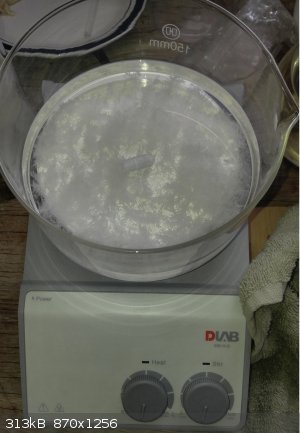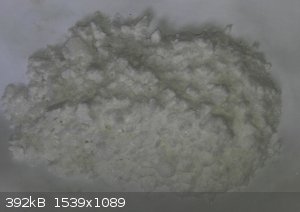
Cou - 26-11-2019 at 22:38
in all the nile red videos, he extracts ASA from aspirin pills using a large volume of acetone, and removes filler. Then he makes salicylic acid by
dissolving that in hot water with acid/base.
he has access to a rotovap to recycle the acetone, but most home chemists would evaporate the acetone outside in a dish for a day. In my experience
with boiling the acetone and recovering by distillation, the resulting ASA is partially decomposed with a very strong acetic acid smell. and i find it
annoying to boil off the acetone b/c it has a very high boiling point elevation constant, so the boiling point of the mixture gradually rises until
you have a liquid with mostly molten ASA decomposing due to high heat, and still a substantial amount of acetone. much better to just let the acetone
evaporate in a dish. but, acetone is expensive and you need a large volume to extract ASA without heating. I regret how much acetone i've wasted doing
this.
The only reason i would want pure ASA is to experiment with making phenyl acetate by decarboxylation of ASA (something i plan to try in the future).
but usually you want salicylic acid, not ASA.
If all you want is salicylic acid, then acetone isnt necessary. Just dissolve the aspirin tablets in boiling hot water. ASA will dissolve, but fillers
will not. and filter through a buchner funnel that has been pre-heated in boiling water. Then add the acid or base to that ASA solution and make
salicylic acid.
I would do the base-promoted ester hydrolysis so I can recover sodium acetate and use that to make some glacial acetic acid. Not wasting any atoms x)
[Edited on 27-11-2019 by Cou]
[Edited on 27-11-2019 by Cou]
Pumukli - 26-11-2019 at 23:52
In theory your method can work. In practice, you may experience problems. 
When I tried something similar a long ago I realised that the inert fillers are sometimes not inert at all against water! E.g. microcrystalline
cellulose, a common "inert" in tablets absorbs water and swell. And makes filtering a real pain. 
Acetone is better: cellulose is not reactive towards this solvent.
Don't count on that acetic acid you would make from the sodium acetate of the hydrolysis of the extracted ASA!
B(a)P - 27-11-2019 at 00:50
I have always found denatured ethanol to work well. It is dirt cheap where I am from, but maybe not the same for you.
XeonTheMGPony - 8-1-2020 at 19:52
I used heated methanol to remove the ASA and leave the gunk behind, then simple distillation to recover bulk of the methanol, then evaporated the rest
down and crashed into ice cold water.
Then recrystallize to ensure good purity (Some odd goo was removed from that step that got picked up during extraction!)
So out of 500ml I only really lost 100ml of methanol.

Water crystallization

After filter and dry

[Edited on 9-1-2020 by XeonTheMGPony]
morganbw - 9-1-2020 at 06:04
This is an old memory but I am fairly certain that I did the extraction using isopropyl alcohol. It was easy and cheap.
Abromination - 9-1-2020 at 07:14
I usually use isopropanol, but on an occasion or two I have had success with hot water extract. Before doing that, I would crush the pills and let the
starch filler separate in a liter of water. Then you can dissolve, do a hot vacuum filtration, and let recrystallize.
Then again, isopropanol is better for this.
CharlieA - 9-1-2020 at 19:17
I followed the procedure in the supplement to Robert Bruce Thompson's "Illustrated Guide to Home Chemistry Experiments." Crude ASA was obtained by
washing aspirin tablets with cold water to remove binders, etc. The crude ASA was recrystallized from 95% EtOH: yield 72%, mp. 133-4*C (lit. 135);
purity 100%+/- ).9% by titration.


